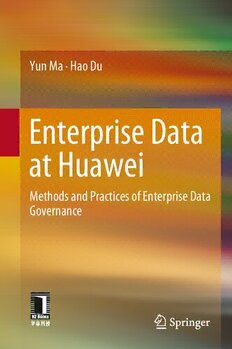
Enterprise Data at Huawei: Methods and Practices of Enterprise Data Governance PDF
Preview Enterprise Data at Huawei: Methods and Practices of Enterprise Data Governance
Yun Ma · Hao Du Enterprise Data at Huawei Methods and Practices of Enterprise Data Governance Enterprise Data at Huawei · Yun Ma Hao Du Enterprise Data at Huawei Methods and Practices of Enterprise Data Governance YunMa HaoDu HuaweiTechnologiesCo.,Ltd. HuaweiTechnologiesCo.,Ltd. Shenzhen,China Shenzhen,China ISBN978-981-16-6822-7 ISBN978-981-16-6823-4 (eBook) https://doi.org/10.1007/978-981-16-6823-4 JointlypublishedwithChinaMachinePress TheprinteditionisnotforsaleinChina(Mainland).CustomersfromChina(Mainland)pleaseorderthe printbookfrom:ChinaMachinePress. TranslationfromtheChineselanguageedition:华为数据之道(EnterpriseDataatHuawei)byYunMa, andHaoDu,©ChinaMachinePress2020.PublishedbyChinaMachinePress.AllRightsReserved. ©ChinaMachinePress2022 Thisworkissubjecttocopyright.AllrightsaresolelyandexclusivelylicensedbythePublisher,whether thewholeorpartofthematerialisconcerned,specificallytherightsofreprinting,reuseofillustrations, recitation,broadcasting,reproductiononmicrofilmsorinanyotherphysicalway,andtransmissionor informationstorageandretrieval,electronicadaptation,computersoftware,orbysimilarordissimilar methodologynowknownorhereafterdeveloped. Theuseofgeneraldescriptivenames,registerednames,trademarks,servicemarks,etc.inthispublication doesnotimply,evenintheabsenceofaspecificstatement,thatsuchnamesareexemptfromtherelevant protectivelawsandregulationsandthereforefreeforgeneraluse. Thepublishers,theauthors,andtheeditorsaresafetoassumethattheadviceandinformationinthisbook arebelievedtobetrueandaccurateatthedateofpublication.Neitherthepublishersnortheauthorsor theeditorsgiveawarranty,expressorimplied,withrespecttothematerialcontainedhereinorforany errorsoromissionsthatmayhavebeenmade.Thepublishersremainneutralwithregardtojurisdictional claimsinpublishedmapsandinstitutionalaffiliations. ThisSpringerimprintispublishedbytheregisteredcompanySpringerNatureSingaporePteLtd. The registered company address is: 152 Beach Road, #21-01/04 Gateway East, Singapore 189721, Singapore Foreword by Tao Jingwen TheThirdIndustrialRevolution,alsoknownastheDigitalRevolution,wasmuchlike thefirsttwointhatittransformedthewayindustriesusedtechnologiesforproduc- tion.However,thisshifttodigitalelectronicshasnotbeenparticularlyeffectiveat minimizingtheoperatingcostsofenterprises.Thatisthemainchallengeaddressed by the nascent Fourth Industrial Revolution. As part of this revolution, digitalized production is seeing wide adoption. This is a new method of production in which dataisanobjecttobeprocessed,ICTplatformsareproductiontools,andsoftware acts as a carrier.Smart technologies and new ICTplatforms help us undertake the challengeofenablingenterprisestocreatethebestproductsandexperiencesinthe mostcost-efficientway. Around the world people in all kinds of industries are actively exploring and advancing digitalization. Industries are leveraging digital technologies to achieve long-termandsustainablegrowth.Asaworld-leadingICTinfrastructureandsmart devicedeveloperwithmorethan30yearsofhistory,Huaweiisalsoworkingtowards digitaltransformation. WhyDoesHuaweiPromoteDigital Transformation? Huawei is a company that encompasses R&D, marketing, manufacturing, supply, procurement, service, and other divisions, but it is not a digital native enterprise (DNE). In the early days of the information era, Huawei built many independent IT systems. That is, we established a closed IT architecture characterized by “one scenario, one IT system and one database”. As a result, data silos have emerged oneafteranother.DifferentITsystemsusedifferentdatalanguages,anddataisnot integratedacrosstheseITsystems.Thesamedataneedstoberepeatedlyenteredin eachsystemthedatausedin.Thereareofteninconsistenciesinthesamedataacross multiple systems. All these issues hinder operational efficiency. Huawei therefore believesthaturgentchangeisneededintheformofdigitaltransformation. v vi ForewordbyTaoJingwen WhatIstheDigitalWorld LikeinHuawei’sBlueprint? Huaweihasablueprintfordigitalizingbusinessobjects,businessprocesses,andbusi- nessrules.Weaimtobuildadataplatformthatisaware,connected,andintelligent. Makingtheplatform“aware”meansestablishingacompleteandeffectivemapping between the physical world and the digital world. “Connected” means connecting andintegratingamyriadofscattereddata.“Intelligent”meansincorporatingbigdata andadvancedmodelsandalgorithmsintoenterpriseprocesses. HowDoesHuaweiImplementDigitalTransformation? Wemustfirstgraspthecruxofdatagovernance.Huaweihasexperienceddifficul- tiesimplementingdatagovernancestemmingfromthehistoricalbaggageofitsIT systemsanddata.Todate,wehaveonlyachievedaqualifiedsuccess.Ouraimisto buildnewdataplatformswithoutcausingdisruptivechangesinexistinginformation systems.Tothatend,weareimplementingautomatedcollectionofdatabyapplying awareness capabilities. Furthermore, we are leveraging our technical expertise to aggregateandlinkdatafromseparatedatabasesaccordingtoclearstandards.These solutions make use of Huawei’s data lake to prevent the formation of data silos in advanceandlayasolidfoundationforin-depthdatagovernance. Digitaltransformationiscurrentlyahottopicamongenterprisesindifferentindus- tries.Itisagreatopportunitybutalsoahugechallengeforenterprises.Inourindustry, thereistoomuchfocusontryingtoadvancetechnologies.However,inmyopinion, digitaltransformationshouldfocusprimarilyonthebenefitstobusinessoperations. WecanfollowPaulRomer’sendogenousgrowththeoryandconsiderthefollowing questionswhenimplementingdigitaltransformation: First, what exactly are the customer problems that need to be resolved through digital transformation? What exactly do users need? What are the concerns of usersandcustomers? Second,whatproblemsshouldourstrategiesbedesignedtoresolve? Finally, is there a well-planned and sustainable architecture available for trans- formation? Digitaltransformationisacontinuousprocessofimprovement.Onceitissetin motion,itdoesnotstop. ForewordbyTaoJingwen vii ThisbooksummarizesHuawei’sexperienceandlessonslearnedfromdatagover- nanceduringHuawei’sdigitaltransformation.Datagovernanceisamatterofexper- tise. We hope that this book can serve as a reference and inspiration for our peers andfacilitateindustrydiscussionandresearchondigitaltransformation. TaoJingwen Director,PresidentoftheQuality BusinessProcessandITManagement Department;CIOofHuawei Shenzhen,China Foreword by Xiong Kang Early in 2017, digitalization was in the ascendant. Guo Ping, Huawei’s Rotating Chairman, proposed in the company’s 817 Transformation Strategy Plan (SP) that weshouldtaketheleadinimplementingdigitaltransformationinternallyandregard providingReal-time,On-demand,All-online,DIY,andSocial(ROADS)experience andcomprehensivelyimprovingoperationalefficiencyasthecommontransforma- tion goals of all business units (BUs) and functional domains. Huawei is a tradi- tional enterprise that integrates R&D, manufacturing, procurement, supply, sales, and service, is involved in 2B and 2C business domains, and has been operating for over 30 years. In light of this fact, when our Executive Steering Committee (ESC)convenedtodiscussthetransformation,thediscussionrevolvedaroundhowto leveragedigitalmeanstocomprehensivelytransformourprocessesandITsystems and reform an operational model that supported the operations of nearly 200,000 employees. For non-digital native enterprises (non-DNEs), digital transformation truly is something transformative. It involves changes to business models and operational models,processes,organizations,ITsystems,culture,andmore.ForHuawei,which wasgrowingrapidly,itwaslikechangingatireinthemiddleofabusyhighway.In 2017,Huawei’sdatawasspreadacrossITsilosinvariousfunctionaldomains,but Huawei also relied on these IT systems to support transactions and analytics on a massivescale.Whathadoncebeenexpedientsolutionsfordatamovementhadnow becomestumblingblocks,andautomationtoolsthathadoncebeenhelpfulwerenow weighingHuaweidown.Datawasownedbydifferentbusinessdepartmentsthathad noinclinationtosharewithoneanother,andeffortstowardachievingdigitaloper- ationwouldalltoooftenamounttoall-nightersinwhichemployeeswouldhastily cobble together Excel spreadsheets. Huawei paid its data scientists very well, but many of them chose to leave because they felt that the lack of available data was thwartingtheirambitions. Afterthoroughdiscussion,theESCreachedaconsensusthatdigitaltransforma- tionshouldbedrivenbybusinessneedsandtechnology,andshouldrevolvearound data. Only by establishing a unified, clean, and intelligent data foundation could ix x ForewordbyXiongKang we support the operations of our new business, satisfy the differentiated require- mentsofvariousmarketsegments,realizereal-timedatavisualization,automation of massive transactions, and algorithm-based decision-making, and build a fully connected,intelligentworld. InOctober2017,theprojectofbuildingaunifieddatafoundationwasinitiated. To address pain points such as frequent data movement, difficulties in finding and accessing data, data unintelligibility, and data unreliability, the project aimed to eliminate data silos, enable digital transformation, and achieve on-demand, agile, self-service,andsecuredatasharingincompliancewithallapplicableregulations. Greatimportancewasattachedtobothdatalakeentryandlinkageanddataconsump- tion,andaftermorethantwoyearsoftirelessworkbytheprojectteam,Huawei’s data foundation was essentially completed. Today, that data foundation supports Huawei’s differentiated operations in over 170 countries, enables transactions and analysis of BGs on a massive scale, and is driving a shift toward online, remote, andcentralizedoperationalmodelsindelivery,supply,finance,andmore.Ithasalso assistedthecompanyinquicklyanalyzingandrespondingtoextremepressurefrom theU.S.Inshort,thedatafoundationhasbecomeacornerstoneofHuawei’sdigital transformation. However,digitaltransformationisnotjustabouttechnologytransformation,and thisisclearlydemonstratedinHuawei’sdatafoundationconstruction.Thisbookis asummaryofHuawei’sdatatransformationpracticesinourdigitaltransformation process.Wehope thatitcanhelpother enterprisesimplementing theirowndigital transformations. We also hope that this book will precipitate a vibrant discussion abouttheseissueswithfriendsfromallwalksoflife. XiongKang DirectoroftheEnterpriseArchitecture andTransformationManagement DepartmentofHuawei Shenzhen,China Foreword by Su Liqing The digital transformation of enterprises has already gathered strong momentum. Throughwell-reasoneddatagovernancemethods,theconstructionofdataplatforms, dataanalysisandmodeling,dataisbeingturnedintoservices,allowingthefreeflow ofdatawithinanenterpriseandbringingenormousvalue.Makingdataaccessibleto thosewhoneeditistheessentialstartingpointfordigitaltransformation. Successfuldigitaltransformationsaredata-driven.Theyarebuiltonthefounda- tionofthecloud,shapedbyanewkindofenterpriseITarchitecture.Butwhatare enterprisestodowiththeexistingITsystemstheyhavebuiltupovermanyyears? Andwhatofthemassivevolumesofhistoricaldatastoredinthoselegacysystems? AcorepartofHuawei’sapproachtodigitaltransformationiswhatwecall“Bi-model IT”.ByintegratinglegacyITsystemsintothenewITarchitectureandenvironment inwhicholdandnewdataandapplications,currentandfutureIoTdata,areallinter- connected,anenterprisecanbuildaunifiedplatform.Onsuchaplatform,machine learning,artificialintelligence(AI),andothertechnologiescanbeappliedtodata, meaningitcancreatemorevaluethaneverbefore. Datacanpotentiallybeappliedtocountlessscenarios,buttodothisinamean- ingfulway,anenterprisemustintegratedataintoallofitsoperations.Whenproblems arise,therelevantdatacanbeanalyzedtofindandswiftlyimplementasolution.The eraofdataishere,andHuawei’sowndigitaltransformationisalreadywellunderway. Thischangecanbeseeneverywhere,fromourfactoryatSongshanLakeinDong- guan,acrossourglobe-spanningsupplychain,toourprojectdeliveriesinmorethan 170countriesandregions.Throughobjectdigitalization,processdigitalization,and rule digitalization, and by integrating IT tools and elements of AI, we are moving beyond ways of working that are based on tedious manual labor, and moving to a newparadigminwhichtheonlineandofflineworldsoperateinstepwitheachother, creatinggenuinevalue. This book presents a systematic account of how Huawei has reinvented its approachtodatagovernanceanddataconsumption.ThechangesHuaweihasmade toitssystemsofdatagovernance,architecture,processesandregulations,ITtools, anddataorganizationsallreflectthechallengesfacingenterprisestoday,andpresent possiblesolutions.Thisbookwillalsodetailcertaininnovationsthatareuniqueto xi
